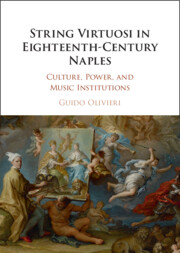Book contents
- String Virtuosi in Eighteenth-Century Naples
- String Virtuosi in Eighteenth-Century Naples
- Copyright page
- Dedication
- Contents
- Figures
- Tables
- Music Examples
- Acknowledgments
- Introduction
- 1 Music Institutions in Naples
- 2 The Formation of the Neapolitan String Virtuosi
- 3 Cello Virtuosi
- 4 Between Naples and Paris
- 5 Neapolitan Virtuosi in the Public Sphere
- 6 Neapolitan Instrumental Music under the Austrian Domination
- 7 Under the Wings of the Imperial Eagle
- Epilogue
- Bibliography
- Index
6 - Neapolitan Instrumental Music under the Austrian Domination
Published online by Cambridge University Press: 13 January 2024
- String Virtuosi in Eighteenth-Century Naples
- String Virtuosi in Eighteenth-Century Naples
- Copyright page
- Dedication
- Contents
- Figures
- Tables
- Music Examples
- Acknowledgments
- Introduction
- 1 Music Institutions in Naples
- 2 The Formation of the Neapolitan String Virtuosi
- 3 Cello Virtuosi
- 4 Between Naples and Paris
- 5 Neapolitan Virtuosi in the Public Sphere
- 6 Neapolitan Instrumental Music under the Austrian Domination
- 7 Under the Wings of the Imperial Eagle
- Epilogue
- Bibliography
- Index
Summary
With the passage of the Viceregno under the control of the Habsburgs in 1707, cultural and artistic exchanges between Naples and Vienna intensified. Sources related to the makeup of the Cappella Reale show two significant trends: the growth of the string section and the introduction and increasing relevance of wind instruments. New documents record the early career in Naples of Francesco Geminiani in connection with the beginnings of the operatic season at the Teatro de’ Fiorentini, where the virtuoso is employed as first violin. Following the outset of the War of the Spanish Succession, Neapolitan musicians were summoned to the Real Capilla of Barcelona, the splendid music chapel established by Archduke Charles of Habsburg to assert his claims to the Spanish throne. When Charles became emperor in 1711 some of these musicians joined the Imperial Chapel in Vienna. The lists of personnel of the Hofmusikkapelle show that a number of virtuosi from Naples formed the core of the string section and contributed to the cosmopolitanism of that ensemble. The prestige of the Neapolitan string school is confirmed by the appointment of Giovanni Antonio Piani, who moved from Paris to Vienna in 1721, at the helm of the Imperial Chapel.
Keywords
- Type
- Chapter
- Information
- String Virtuosi in Eighteenth-Century NaplesCulture, Power, and Music Institutions, pp. 185 - 204Publisher: Cambridge University PressPrint publication year: 2023



